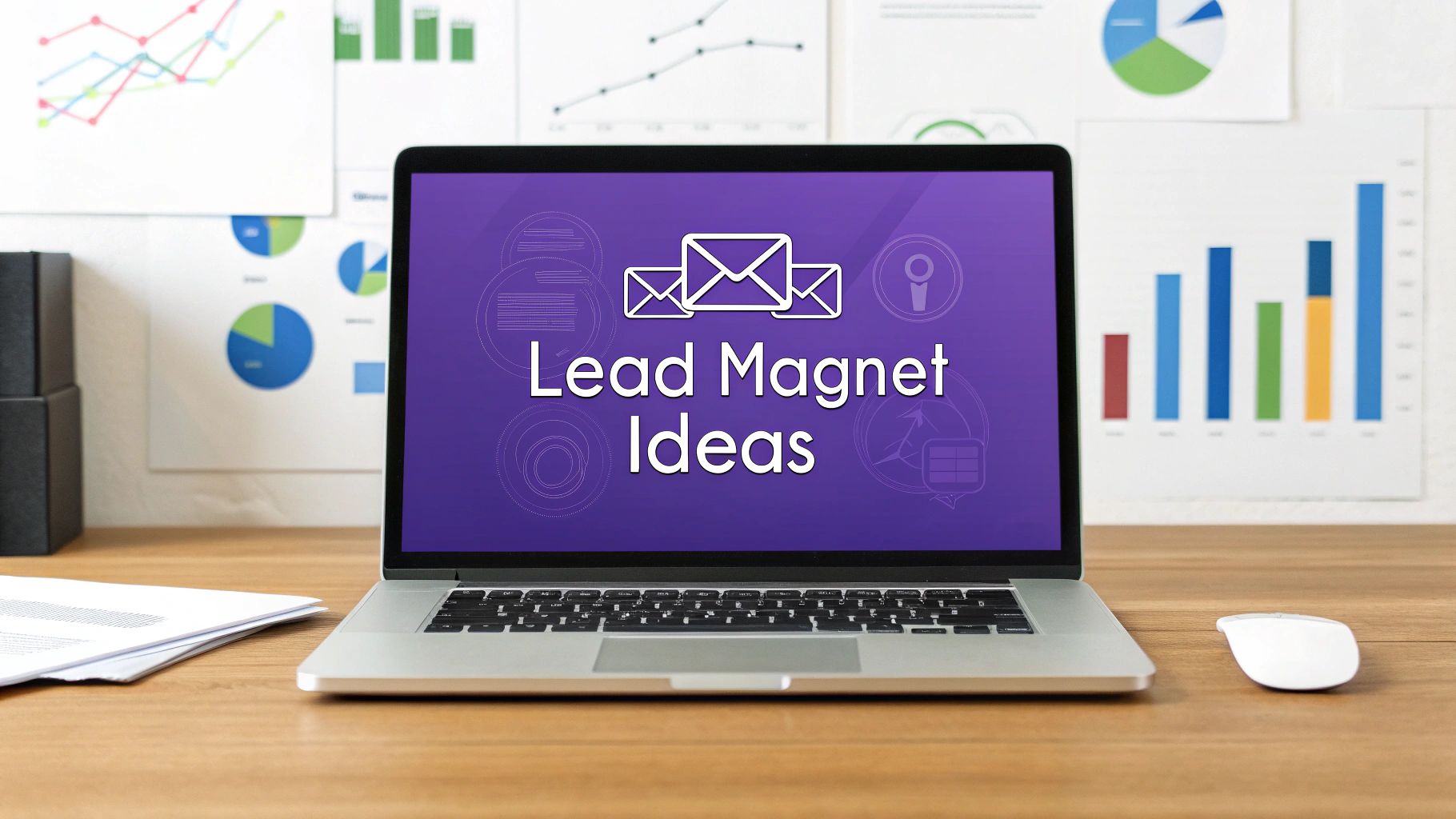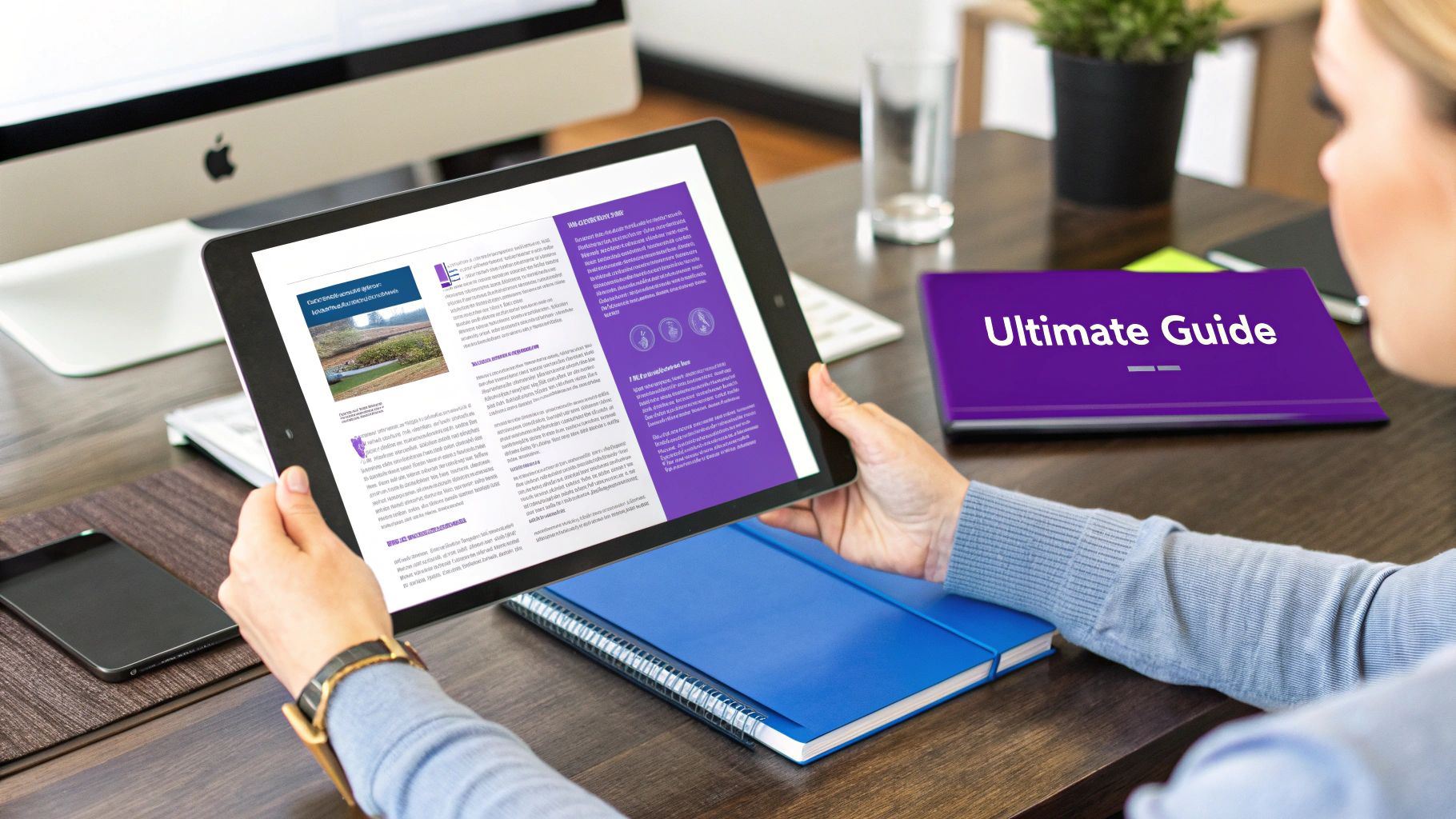10 High-Converting Ideas for Lead Magnets in 2025

In a competitive online space, a generic offer is easily ignored. To build a high-quality email list and capture the attention of your ideal audience, you need compelling, high-value incentives that solve a specific problem. A well-crafted lead magnet does more than just gather contact information; it establishes your authority, builds initial trust, and serves as the crucial first step in a lasting customer relationship. Forget the basic, overused approaches that yield low-quality prospects.
This guide moves past the obvious, exploring 10 proven ideas for lead magnets that deliver tangible value. We provide actionable frameworks you can use immediately to create irresistible offers that attract genuinely interested leads. For each idea, we will break down:
- What makes it effective and why it resonates with specific audiences.
- Who it’s best suited for, from SaaS founders to freelance advisors.
- How to implement it for maximum impact, ensuring your efforts translate into growth.
The goal is to equip you with a diverse toolkit of strategies, enabling you to select and build the perfect lead magnet that not only converts but also perfectly aligns with your business objectives and sets the stage for future sales.
1. The Ultimate Guide/E-book
The ultimate guide or e-book is a cornerstone among ideas for lead magnets, serving as a comprehensive, long-form PDF resource that delves deep into a specific topic. This lead magnet works by offering substantial, authoritative value that feels more than fair in exchange for a prospect's email address. It positions your brand as a go-to expert, building trust and credibility long before a sales conversation begins.

This approach is highly effective for complex B2B sales cycles or high-consideration purchases where prospects conduct extensive research. By providing a definitive resource, you capture leads at the top of the funnel and nurture them with genuinely helpful content. Think of the detailed handbooks from Shopify or HubSpot's legendary 'Ultimate Guide to Inbound Marketing'.
How to Implement This Lead Magnet
- Solve a Singular, High-Value Problem: Instead of a broad overview, focus your e-book on solving one specific, pressing challenge for your ideal customer. A title like "The SaaS Founder's Guide to Reducing Churn" is more compelling than "A Guide to SaaS."
- Invest in Professional Design: Use tools like Canva or Venngage for a polished look, or hire a designer. A professional cover and clean internal layout significantly boost perceived value.
- Structure for Skimmability: Break up chapters with clear headings, bullet points, checklists, and summary boxes. Include a table of contents to help readers navigate the content easily.
- Embed Actionable Next Steps: Each chapter should end with a clear takeaway or an actionable tip the reader can implement immediately. This makes the content practical and memorable.
2. Checklists and Cheat Sheets
Checklists and cheat sheets are powerful ideas for lead magnets because they offer immense value in a highly digestible format. These quick-reference documents distill complex processes into simple, actionable steps, providing immediate utility. Prospects download them to save time, avoid mistakes, and ensure they cover all necessary bases for a specific task.

This approach is perfect for audiences who need practical, repeatable frameworks. It positions your brand as a helpful guide that simplifies their workflow. Think of CoSchedule's famous blog post promotion checklist or Backlinko's comprehensive on-page SEO checklist. These resources are not just downloaded; they are printed, bookmarked, and used regularly, keeping your brand top of mind.
How to Implement This Lead Magnet
- Focus on a Repeatable Process: Identify a task your audience performs frequently, like launching a website, creating content, or preparing for a sales call. The more often they use it, the more valuable it becomes.
- Use Clear, Action-Oriented Language: Start each checklist item with a verb (e.g., "Write," "Publish," "Analyze"). This makes the steps unambiguous and easy to follow.
- Design for Print and Digital Use: Create a clean, one or two-page PDF that looks good on-screen and is easy to print. Use checkboxes, icons, and your brand colors to make it visually appealing and functional.
- Include Pro-Tips or Links: Add brief notes, helpful hints, or links to more in-depth resources alongside key steps. This adds another layer of value and drives traffic back to your site.
3. Free Templates and Worksheets
Templates and worksheets are some of the most practical and high-converting ideas for lead magnets. They provide immediate, tangible value by helping your audience solve a problem or execute a task more efficiently. Instead of just learning how to do something, users get a ready-made tool to start doing it right away. This builds an instant connection and showcases your brand's utility.
This approach is perfect for audiences who are action-oriented and looking for shortcuts to achieve their goals. By providing a customizable social media content calendar, a budget planning spreadsheet, or a business plan template, you save them time and effort. Brands like Canva and HubSpot have mastered this by offering vast libraries of templates that not only capture leads but also integrate users directly into their product ecosystems.
How to Implement This Lead Magnet
- Identify a Repetitive, High-Effort Task: Pinpoint a task your target audience performs regularly that is time-consuming or complex. Creating a template that simplifies this process guarantees high demand.
- Design for Customization and Clarity: Your template should be intuitive and easily adaptable. Use clear labels, include instructional comments, and incorporate your branding subtly with brand colors and logos.
- Provide an Example: Include a "filled-out" version or a tab with sample data to show users exactly how the template should be used. This removes guesswork and reduces friction.
- Choose the Right Format: Offer your template in a universally accessible format like Google Sheets, Google Docs, a Canva template link, or a PDF with fillable fields. Learn more about creating a powerful lead magnet to ensure it delivers maximum value.
4. Free Webinar or Video Series
A free webinar or video series is a powerful lead magnet that offers live or on-demand training directly to your audience. This format excels by creating a direct, personal connection and demonstrating your expertise in real-time. It works by trading high-value, actionable education for an email address and an hour of a prospect's time, establishing significant trust and authority.

This approach is ideal for B2B tech, coaching, and consulting, where demonstrating a product or teaching a complex process drives conversions. By hosting an engaging session, you capture highly qualified leads who are actively seeking solutions. Industry leaders like Amy Porterfield and Russell Brunson have built entire empires using webinars to teach, engage, and sell. If you want to dive deeper into this method, you can learn more about how webinars are used for lead generation on speakerstacks.com.
How to Implement This Lead Magnet
- Choose an Evergreen, High-Impact Topic: Focus on a recurring pain point your audience faces. A topic like "5 Simple SEO Tweaks to Double Your Traffic" will attract more sign-ups than a niche, time-sensitive subject.
- Promote Across Multiple Channels: Use email, social media, and paid ads to drive registrations. Create a dedicated landing page that clearly outlines the webinar's value proposition, key takeaways, and speaker bio.
- Engage and Interact: During the live session, use polls, Q&A segments, and chat features to keep the audience engaged. This transforms a passive viewing experience into an interactive workshop.
- Follow Up Strategically: Send the recording to all registrants within 24 hours. Follow up with a tailored offer or call-to-action that logically extends from the webinar content, nurturing them further down the funnel.
5. Quiz or Assessment Tool
A quiz or assessment tool is one of the most engaging ideas for lead magnets, transforming passive content consumption into an active, personalized experience. This interactive approach works by asking a series of questions and providing customized results in exchange for an email address. It’s highly effective because it satisfies the user's curiosity and provides immediate, personal value.
This method allows you to segment your audience based on their answers, providing deep insights into their needs, challenges, and goals. For example, a marketing agency might create a "What's Your Marketing Maturity Score?" assessment, while an e-commerce brand could use a "Find Your Perfect Skincare Routine" quiz. The results not only capture a lead but also qualify them, making future communication far more relevant and effective.
How to Implement This Lead Magnet
- Define a Clear Outcome: Your quiz should solve a problem or answer a specific question for the user. Ensure the title clearly communicates this value, such as "Discover Your Leadership Style" or "Calculate Your Business's Growth Potential."
- Keep it Short and Engaging: Aim for 5-10 simple, multiple-choice questions that are easy to understand and quick to answer. Incorporate a conversational tone and visuals to maintain user interest throughout the process.
- Deliver High-Value, Personalized Results: The results page is the payoff. Provide a genuinely insightful outcome that explains what their answers mean. Offer specific advice, resources, or next steps tailored to their result category.
- Use Results for Segmentation: Connect your quiz tool (like Interact or Typeform) to your email marketing platform. Create automated email sequences that deliver targeted content based on the user's specific quiz outcome, nurturing them with highly relevant information.
6. Free Trial or Sample
A free trial or sample is one of the most powerful ideas for lead magnets because it removes the biggest barrier to purchase: uncertainty. By offering temporary, no-cost access to your product or a sample of your service, you allow prospects to experience its value firsthand. This "try before you buy" model is incredibly effective for SaaS platforms, software, and subscription services where the user experience is a key selling point.
This bottom-of-the-funnel lead magnet generates highly qualified leads who have already engaged with your solution. Instead of just reading about benefits, they live them. Think of the seamless trials offered by Adobe Creative Cloud, Salesforce, or Spotify. The goal is to make the product so indispensable during the trial period that converting to a paid plan becomes the logical next step for the user. It transforms a theoretical solution into a tangible, necessary tool.
How to Implement This Lead Magnet
- Define Clear Trial Limitations: Decide whether your trial will be limited by time (e.g., 14 days), features (e.g., access to basic tools only), or usage (e.g., 3 projects). The limit should provide enough access for users to experience a core "aha!" moment.
- Create a Frictionless Onboarding Experience: The moment a user signs up, guide them with a simple, engaging onboarding sequence. Use tooltips, welcome emails, and in-app checklists to show them exactly how to achieve their first quick win.
- Nurture Users Throughout the Trial: Don't just grant access and disappear. Send automated emails with helpful tips, use cases, and tutorials that align with the user's goals. This proactive support demonstrates your commitment to their success. For more information on leveraging lead capture in different settings, you can check out details on lead capture for events on speakerstacks.com.
- Make Upgrading Effortless: As the trial nears its end, communicate the value they’ll lose and make the upgrade path clear and simple. A one-click upgrade process from within the application dashboard is ideal for a smooth transition.
7. Exclusive Discount or Coupon Code
An exclusive discount or coupon code is one of the most direct and compelling ideas for lead magnets, particularly for e-commerce and B2C businesses. This lead magnet works by offering an immediate, tangible financial incentive in exchange for an email address. The promise of savings taps into a powerful psychological trigger, encouraging quick action from prospects who are close to making a purchase decision.
This approach is highly effective for converting bottom-of-the-funnel traffic into both leads and customers simultaneously. By providing a clear, quantifiable benefit, you reduce friction in the buying process and give hesitant shoppers a final nudge to complete their order. Think of the ubiquitous "10% off your first order" pop-ups on retail websites or the special offers from brands like Groupon.
How to Implement This Lead Magnet
- Make the Discount Meaningful: The offer must be attractive enough to justify sharing personal information. A 5% discount may not be enough, whereas a 15-20% off coupon or a "free shipping" offer often provides a strong enough incentive.
- Create a Sense of Urgency: Set a reasonable expiration date for the coupon. This encourages immediate use and prevents the offer from being forgotten, driving faster conversions.
- Use Unique, Trackable Codes: Generate unique, one-time-use codes for each subscriber. This prevents sharing and allows you to track the effectiveness of your lead magnet campaign accurately.
- Simplify the Redemption Process: Ensure the process for applying the discount at checkout is simple and intuitive. Any friction at this stage can lead to cart abandonment, defeating the purpose of the offer.
8. Resource Library or Toolkit
A resource library or toolkit acts as a gated, curated hub of valuable assets, positioning your brand as an indispensable guide in your niche. Instead of a single download, you offer ongoing access to a collection of tools, templates, guides, and links in exchange for an email. This approach provides continuous value, encouraging subscribers to return to your brand's ecosystem repeatedly.
This lead magnet excels because it attracts highly motivated individuals actively seeking solutions. By curating the best resources, you save your audience time and effort, building immense goodwill. Think of Buffer's social media toolkit or the extensive design asset libraries offered by Canva. This model transforms a one-time transaction into a long-term relationship.
How to Implement This Lead Magnet
- Curate with a Clear Focus: Build your library around a specific role or goal. For instance, create a "Startup Founder's Launch Kit" with pitch deck templates, fundraising checklists, and legal document links, rather than a generic business library.
- Organize for Easy Navigation: Structure the library with clear categories and a search function. Use intuitive labels like "Templates," "Checklists," and "Recommended Software" so users can find what they need without frustration.
- Continuously Add Value: Keep the library dynamic by regularly adding new resources. Send email updates to your list announcing new additions, which drives re-engagement and reinforces the value of their subscription.
- Include a Mix of Original and Curated Content: Offer a blend of your own proprietary templates and guides alongside links to trusted external tools and articles. This demonstrates both your expertise and your knowledge of the broader industry landscape.
9. Mini Email Course or Challenge
A mini email course or challenge is a sequence of educational emails sent over several days, designed to teach a skill or help a subscriber achieve a specific outcome. This lead magnet idea stands out because it builds a relationship over time, training new subscribers to open and engage with your emails from the very beginning. Instead of a one-time download, it delivers value incrementally, keeping your brand top-of-mind.
This approach is perfect for nurturing leads who need to build confidence before they are ready to purchase a more complex product or service. It establishes your expertise by guiding them toward a tangible result, making it a powerful tool for coaches, consultants, and SaaS companies. Think of a 5-day social media growth challenge or a 7-day course on improving productivity.
How to Implement This Lead Magnet
- Define a Clear, Achievable Outcome: The course or challenge must have a specific, measurable end goal. A "7-Day Challenge to Land Your First Freelance Client" is far more compelling than a general "Freelancing Tips" email series.
- Structure Each Lesson for Action: Keep each email focused on one core concept with a single, clear call to action or "homework" assignment. This creates momentum and gives subscribers a sense of accomplishment.
- Build Anticipation and Community: End each email by teasing the next lesson to keep subscribers engaged. Consider creating an optional, simple community space like a Facebook group or Slack channel for participants to share their progress.
- Automate the Delivery Sequence: Use your email marketing platform to create an automated workflow. This ensures every new subscriber gets the full experience on a predefined schedule without manual intervention.
10. Industry Report or Research Study
An industry report or research study is a premium lead magnet that offers original data, exclusive survey results, or compiled industry trends. This approach works by providing unique, data-backed insights that your audience cannot find elsewhere, positioning your brand as a primary source of authoritative information and thought leadership. It's a powerful way to generate high-quality leads and earn valuable media mentions.
This method is exceptionally effective for B2B companies aiming to establish credibility and influence decision-makers. By publishing proprietary research, you create a shareable asset that generates organic backlinks and social proof. Renowned examples like HubSpot's "State of Marketing Report" or Salesforce's industry-specific studies demonstrate how this tactic can become a cornerstone of a content marketing strategy.
How to Implement This Lead Magnet
- Focus on a Niche Question: Instead of a broad industry overview, investigate a specific, timely question your audience is asking. For example, "The State of AI Adoption in Mid-Market SaaS" is more compelling than "A Report on SaaS Trends."
- Visualize Your Data: Raw numbers can be overwhelming. Use charts, graphs, and infographics to make your findings digestible and visually appealing. Tools like Flourish or Infogram can help you create professional data visualizations.
- Highlight Surprising Insights: Pull out the most counterintuitive or newsworthy findings and feature them prominently in your introduction and promotional materials. These "aha!" moments are what make reports memorable and shareable.
- Provide Actionable Implications: Don't just present data; tell your audience what it means for their business. Conclude each section with clear takeaways and strategic recommendations based on the research.
Comparing Different Types of Lead Magnets
Choosing the right lead magnet depends on your audience, resources, and goals. Here’s a breakdown of each type to help you compare.
The Ultimate Guide/E-book
- Complexity: High – time-intensive and detailed.
- Resources: High – requires design, research, and updates.
- Best For: B2B, educational brands, consultants, and SaaS looking to establish authority with evergreen content.
Checklists and Cheat Sheets
- Complexity: Low – quick to create and update.
- Resources: Low – simple design and content are sufficient.
- Best For: Marketing agencies, productivity coaches, or technical fields where easy, shareable, and mobile-friendly guides are valued.
Free Templates and Worksheets
- Complexity: Medium – requires expertise to create something truly useful.
- Resources: Medium – needs good design and customization options.
- Best For: Design agencies, consultants, and financial or HR professionals who can provide practical, time-saving tools.
Free Webinar or Video Series
- Complexity: High – involves prep, tech setup, and presentation skills.
- Resources: High – requires time, skills, and technology tools.
- Best For: Coaches, SaaS companies, and B2B educators who want to build a personal connection and drive immediate conversions.
Quiz or Assessment Tool
- Complexity: Medium-High – often needs a dedicated platform or developer help.
- Resources: Medium – requires content creation and potential platform fees.
- Best For: E-commerce, personal development, and marketing brands that can benefit from personalized results and audience segmentation.
Free Trial or Sample
- Complexity: High – the product or service must be ready for users.
- Resources: High – needs onboarding, tracking, and customer support.
- Best For: SaaS, software, streaming services, and online courses that can remove purchase barriers and build user confidence through experience.
Exclusive Discount or Coupon
- Complexity: Low – simple to implement.
- Resources: Low – requires tracking and code creation.
- Best For: E-commerce, retail, and subscription businesses aiming for an immediate sales boost by appealing to price-sensitive customers.
Resource Library or Toolkit
- Complexity: Medium-High – requires ongoing curation and organization.
- Resources: Medium – needs hosting, updating, and good organization.
- Best For: Creative agencies, marketers, and educators who want to become a go-to authority by providing a wide range of valuable resources.
Mini Email Course or Challenge
- Complexity: Medium-High – content must be planned and automated.
- Resources: Medium – requires content planning and an email automation platform.
- Best For: Coaches, wellness experts, and educators looking to build an ongoing relationship and nurture long-term leads.
Industry Report or Research Study
- Complexity: High – requires significant research and analysis.
- Resources: High – needs expertise, data collection, and analysis tools.
- Best For: B2B firms, consulting agencies, and industry publications aiming to establish thought leadership and earn media coverage.
From Idea to Implementation: Choosing Your Next Lead Magnet
We've explored a comprehensive list of powerful ideas for lead magnets, from in-depth e-books and industry reports to interactive quizzes and time-saving checklists. The sheer variety demonstrates a crucial truth: there is no single "best" lead magnet. The most effective option is the one that perfectly aligns with your audience's needs, your business goals, and the unique value you offer.
The common thread connecting a successful webinar series to a high-converting template is genuine, actionable value. Your lead magnet is the first tangible promise you make to a potential customer. It must solve a specific problem, answer a pressing question, or provide a clear shortcut to a desired outcome. A generic, surface-level offer will fail to convert, while a resource packed with specific insights will build trust and establish your authority from the very first interaction.
Turning Knowledge into Actionable Leads
The key takeaway is to move from passive consideration to active implementation. Don't let this extensive list of ideas for lead magnets become a source of overwhelm. Instead, view it as a menu of opportunities. Your next step isn't to create all ten of these assets; it's to choose just one that you can execute exceptionally well.
Consider these critical factors when making your decision:
- Audience Needs: What is the most significant pain point your ideal customer faces right now? A BDR might crave a cold email template, while a SaaS founder might be desperate for a product-led growth checklist. Match the format to their immediate problem.
- Your Unique Expertise: Where does your knowledge shine brightest? If you have access to proprietary data, an industry report is a natural fit. If you excel at simplifying complex processes, a cheat sheet or worksheet will be highly effective.
- Business Goals: Are you aiming to qualify leads for a high-ticket consulting service or drive sign-ups for a SaaS free trial? A detailed assessment tool is ideal for the former, while a product-focused mini-course works well for the latter.
A Practical Path Forward
Once you've selected your ideal lead magnet, focus on a frictionless delivery experience. The goal is to capture interest the moment it peaks. For professionals who speak at events, host webinars, or lead workshops, this is especially critical. The fleeting attention of an audience is a golden opportunity for lead generation.
Imagine concluding your presentation and instantly directing attendees to a single, simple link or QR code on your final slide. They can immediately access your promised checklist, guide, or webinar recording without navigating a complex website. This seamless transition from engaged listener to qualified lead is what transforms a good speaking engagement into a powerful business development engine. By choosing the right asset and delivering it flawlessly, you create a system that consistently turns your expertise into tangible business growth.
Ready to turn your speaking engagements into a lead generation machine? SpeakerStacks provides a simple, branded landing page to share your lead magnets, slides, and links with a single QR code. Stop losing audience members after your talk and start capturing high-quality leads in the moment by visiting SpeakerStacks today.